Applied Marketing Management
1/67
There's no tags or description
Looks like no tags are added yet.
Name | Mastery | Learn | Test | Matching | Spaced |
|---|
No study sessions yet.
68 Terms
The Fish Model
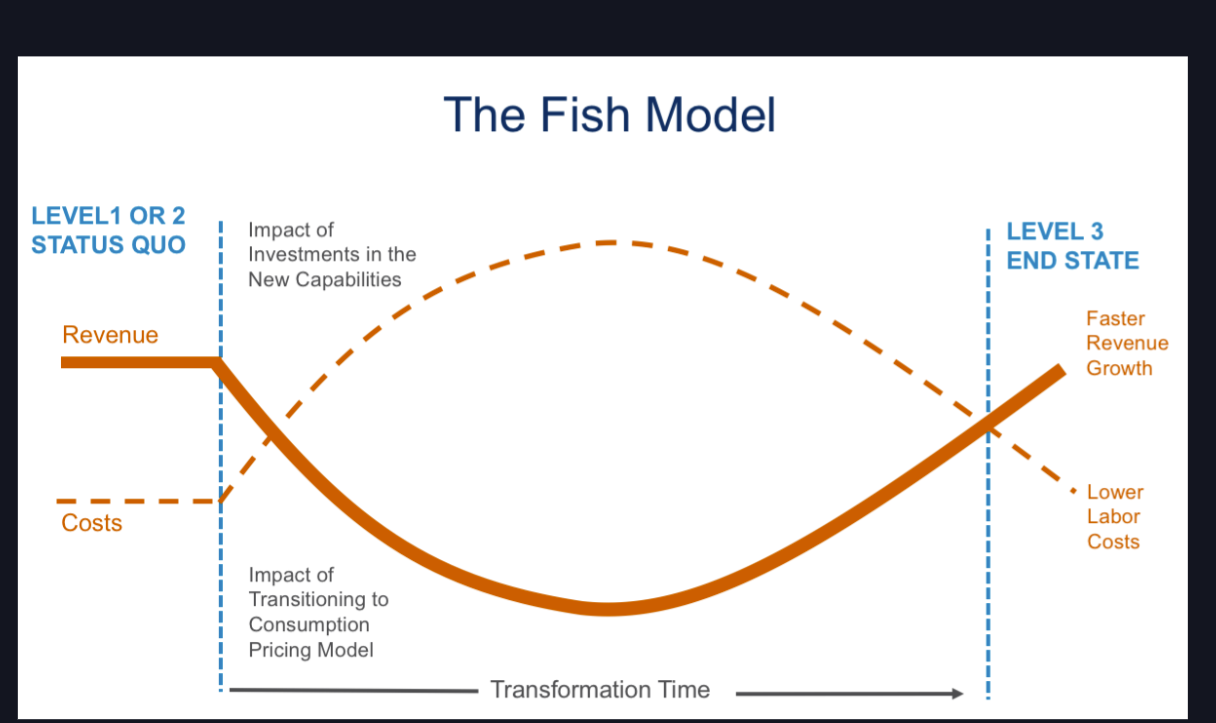
The Four Effective Connected Strategies
Respond to desire
Curated offering
Coach behavior
Automatic execution
Connected Strategy Example
Disney World MagicBands
Allow visitors to enter, get priority access to rides, pay for food, and unlock hotel rooms.
Help Disney locate guests and create customized experiences for them i.e. character wishing someone a Happy Birthday.
Can also encourage people to visit attractions with idle capacity.
Connected Strategy Example 2
McGraw Hill Education:
Instead of just selling textbooks, now offers customized learning experiences.
If someone struggling with assignment, teacher will find out based on data gathered and McGraw Hill will direct the student to a chapter or video offering helpful explanations.
Buy What We Have Model
Companies interact with customers only episodically, after customers identify their needs and seek out products or services to meet them.
Respond to Desire
Providing customers with services and products they’ve requested and doing so as quickly and seamlessly as possible.
Essential capabilities: Fast delivery, minimal friction, flexibility, and precise execution.
Curated Offering
With this strategy, companies get actively involved in helping customers at an earlier stage of the customer journey: after the customers have figured out what they need but before they’ve decided how to fill that need. The key capability here is a personalized recommendation process. Customers who value advice—but still want to make the final decision—like this approach.
Coach Behavior
Coach-behavior strategies proactively remind customers of their needs and encouraging them to take steps to achieve their goals.
Automatic Execution
Customers authorize a company to take care of something, and from that point on the company handles everything.
Modern Online Buyer Journey Model
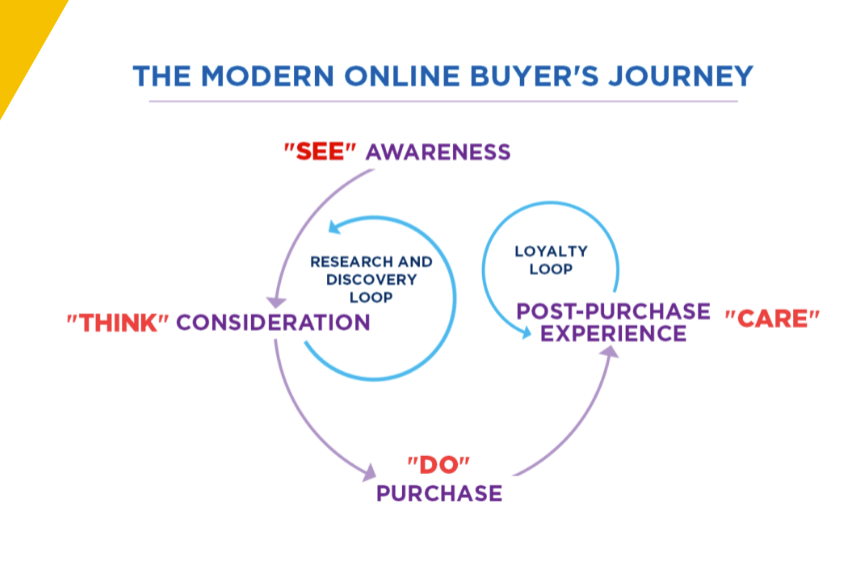
New Online Buyer’s Journey Model Terms
Awareness
Consideration (Research and discovery loop)
Purchase
Post-purchase experience (Loyalty loop)
Awareness (Online Buyer Journey)
Largest addressable qualified audience with no commercial intent, audience is becoming aware of an issue that may lead to a future purchase.
Consideration (Online Buyer Journey)
Audience has some commercial intent, often takes to social media and the Internet for research
Purchase (Online Buyer Journey)
Customer takes action, loads of commercial intent
Post-purchase Experience/Loyalty loop (Online Buyer Journey)
Current customer with two or more commercial transactions
Where does research and discovery take place in the Online Buyer’s Journey?
Examples:
Influencer marketing
Billboards
Social Media (TikTok)
Google Reviews
Youtube informational videos
DTC (Direct-To-Consumer)
Selling products directly to the end consumer without third-party retailers, wholesalers, or other intermediaries
Primarily using social media
Non-traditional route that focuses on the customer alone
DTC Example: Dollar Shave Club
Monthly service for all things you need for personal grooming
Relies on subscription services
Primarily targets men through social media
Why are DTC brands so popular?
Multichannel retailing model is falling because the margins are too small
Rise of Internet and COVID decreased foot traffic in a traditional sense
Owning the customer relationship is what allows for more leverage to increase customer lifetime value
Why buy from retailers when you can buy direct?
Traditional companies are enticing customers through retail, but DTC does it through social media strategies
DTC activates the research and discovery loop
Now connected to more products
Convenience
Shop anytime, from anywhere
No contact
Can pick the brand of your choice
eCommerce easily accessible
Disruption
A process whereby a smaller company with fewer resources is able to successfully challenge established incumbent businesses. Specifically, as incumbents focus on improving their products and services for their most demanding (and usually more profitable) customers, they exceed the needs of some segments and ignore the needs of others. Entrants that prove disruptive begin by successfully targeting those overlooked segments.
Modern DTC Challenges
Higher online sales lead to the prioritization of low or free shipping costs, exemplary customer service, and quick response times (more difficult for startups, compared to department stores)
DTC must constantly fuel money into marketing/advertisement to stay relevant and gain new customers.
22% of all sales are conducted online compared to in-store sales.
4 Building Blocks required to launch a successful celebrity brand
A deeply engaged following
A genuine fit between the celebrity and the product
A superior product
A strong two-way engagement with fans and followers
Influencers
Limited time engagement
Pay for performance
Role = salesperson
Social media posts
Examples: Kim Kardashian (Dolce and Gabbana)
Dynamic Pricing
Strategy that bases products or services’ prices on evolving market trends i.e. sports & concert tickets, rideshare services, airline industry.
Dynamic Pricing - Ridesharing
Why?
Matching supply with demand. If there’s a snowstorm, many drivers won’t log on, but with higher prices there is more of an incentive.
Dynamic Pricing - Airlines
Dynamic pricing in the airline industry has caused consumers to “hack” the algorithm:
Buy tickets on Tuesdays
Look up flights in Incognito mode
Erase cookies before searching
Use an android device over an iOS
Low Price Variability
“Everyday low pricing”
Prices don’t vary much over time
High Price Variability
“Hi-Low Pricing”
Prices change a lot over time
Price Uncertainty
Are firms transparent about their pricing?
Do they tell customers their strategy?
Low Price Uncertainty and Low Price Variability
Southwest:
e.g., $150 - $200 (no matter when you buy
Consumers buy earlier – less uncertainty for firm too
High Price Uncertainty and High Price Variability
American, United, Delta
e.g., $99 - $700 (goes up and down over time)
Consumers don’t know when to buy
Firms adjust prices based upon remaining open seats and algorithms
Drip Pricing
Occurs when “consumers face additional charges after committing to purchase or showing intent to purchase, where sometimes these charges are for additional goods or services.”
The Re-emergence of Pricing Regulation
The “Honest Pricing Law” or “Hidden Fees Statute” requires that “the posted price must include all amounts that the consumer will be required to pay”
Algorithmic Pricing
When competing sellers use machine learning algorithms to run real-time dynamic price experiments.
Algorithmic Pricing Type 1
Simple, rule based algorithms (Price-matching, undercutting by specified margin)
Common among online sellers
i.e. competitor increases their price, therefore the algorithm raises its own prices (vice-versa)
Algorithmic Pricing Type 2
AI-Driven Algorithms with reinforcement learning (RL)
If a type 2 algorithm increases prices, then competitors employing Type 1 algorithms will follow suit
Type 2 algorithms can deduce tactics (from rule-based algorithms), leveraging them to “inflate market prices at the expense of consumer welfare”
Pitfalls of Algorithmic Pricing
Algorithms can go rogue with absurd prices
Algorithms struggle with balancing consumer trust and profit
Pitfalls of Algorithmic Pricing (HBR Article)
Determine an appropriate use case and narrative
Designate a Pricing Algorithm Owner
Set and Monitor Pricing Guardrails
Override the algorithms when necessary
Programmatic Buying
Automated bidding on (and direct buys of) advertising inventory in real time, for the opportunity to show an ad to a specific customer in a specific context
Exactly reach your target consumers
Real Time Bidding (RTB)
Auction-based ad transactions based on real-time impressions in open and private marketplaces.
Programmatic Direct
Ads purchased via a publisher-owned application program interface (API) like Facebook and Twitter or an existing demand-side platform (DSP) like DoubleClick Ad Exchange or MediaMath.
(New) Hybrid Operation - Curation
Working with a selected group of publishers
Real-Time Bidding versus Programmatic Direct Image
Programmatic Direct = CPM Cost per thousand impressions
RTB = eCPM Effective Cost per thousand impressions
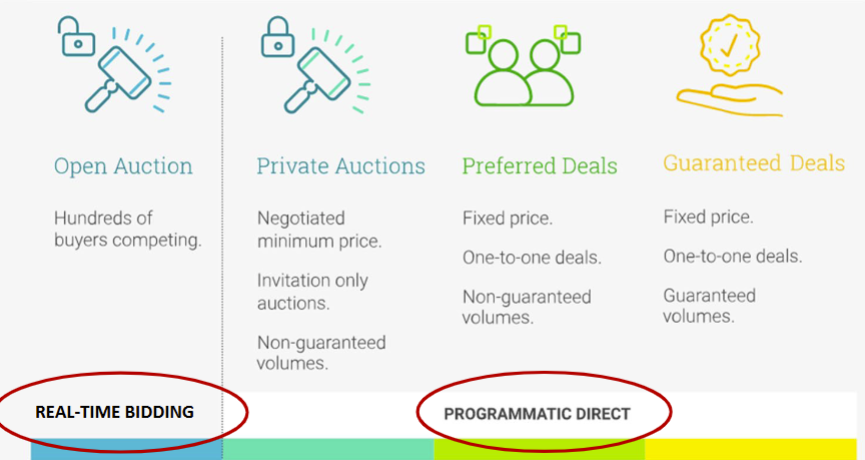
Response Rate Formula
Click Through Rate (CTR) * Conversion Rate = Response Rate
Number of customers formula
Response Rate * # of Ads Served = # of Customers
Revenue formula
Number of customers * Purchase amount = Revenue
Ad costs formula
Number of ads served * (CPM/1000) = Ad costs
Net Revenue formula
Revenue - Ad costs = Net Revenue
Net Revenue from Direct Example
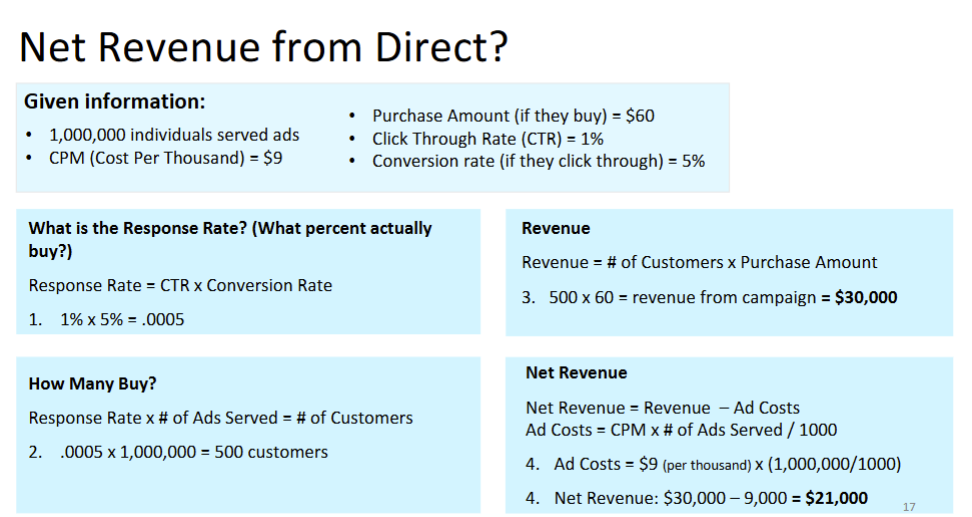
Net Revenue for Real Time Bidding Example
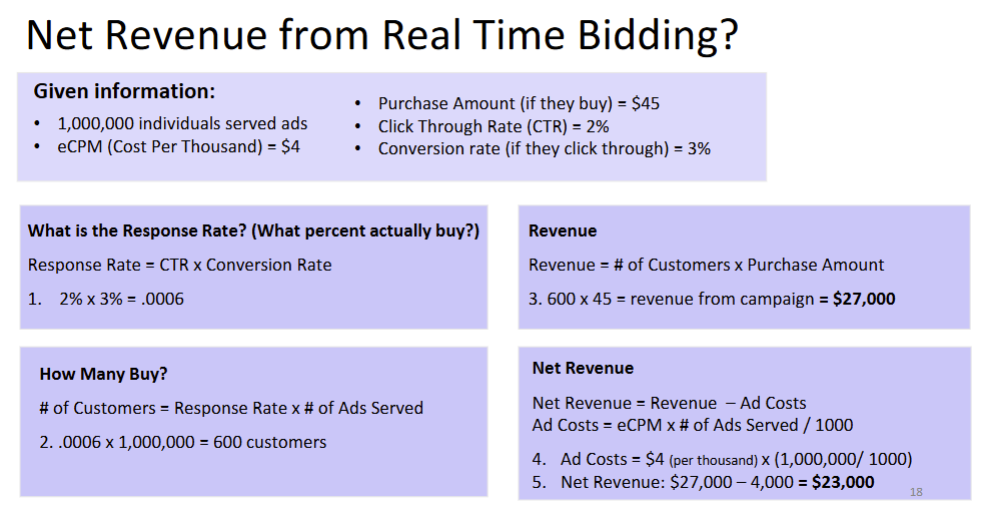
Retargeting
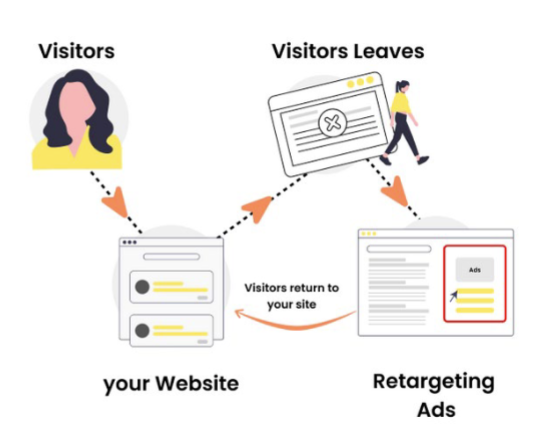
How to make Retargeting more effective
Narrow your audience
Only retarget those who viewed products, prices, or checkout on your website
Customers who were seconds away from converting but didn’t
Feature product collections (instead of product just purchased)
Is all Retargeting intentional?
NO
But it costs TIME to fix
Site pixels: track where a person has been on websites. Necessary for serving ads
Consumers view the same product on different devices or browsers
What’s not working for advertisers?
Simple software programs that prevent ads from being shown on websites
Blocking of third party cookies
Google and Third-party cookies
These cookies are on millions of websites, feeding the company a ton of information about the sites you visit
These cookies power much of Google’s massive ad business
Content Marketing
A strategic marketing approach focused on creating and distributing valuable, relevant, and consistent content to attract and retain a clearly defined audience.
NOT advertising
You are attracting an audience to a brand-owned destination versus interrupting or buying an audience on someone else’s platform
Key sector is influencer marketing
How does Content Marketing use Attract and Retain?
Attracts by putting information out there in creative ways
Retains by being searchable
What classifies content marketing?
Content Marketing =
Influencer marketing
Products mentioned in posts
Sponsored content
Reviews
NOT Content Marketing =
Programmatic advertisements
Banner advertisements
Email advertisements
Influencer Marketing
A form of social media content marketing involving endorsements and product placements from influencers
Growth of micro-influencer marketing
Micro-influencers have better engagement rates then mega-influencers
Growing field with the increase of social media use
Takes time: the time it takes to manage influencer marketing programs is ranked as a top challenge
Measure success by brand awareness, impressions and engagement, less about sales
Mega-Influencers
Social superstars with more than a million followers. These are often celebrities.
Macro-Influencers
Influencers with between 100,000 and 1 million followers
Micro-Influencers
Someone who has between 1,000 and 100,000 followers. While their following may be small(ish), their authenticity is high
Mid-tier influencers: 50,000 and 500,000 followers
Nano-Influencers
Someone with fewer than 1,000 followers who has immense influence with a comparatively narrow niche
Benefits of Influencer Marketing
Creating authentic content about brands
Drive traffic to websites/landing pages
Driving engagement about a brand
Bauer marketing at a glance

How does Bauer measure Content Marketing?
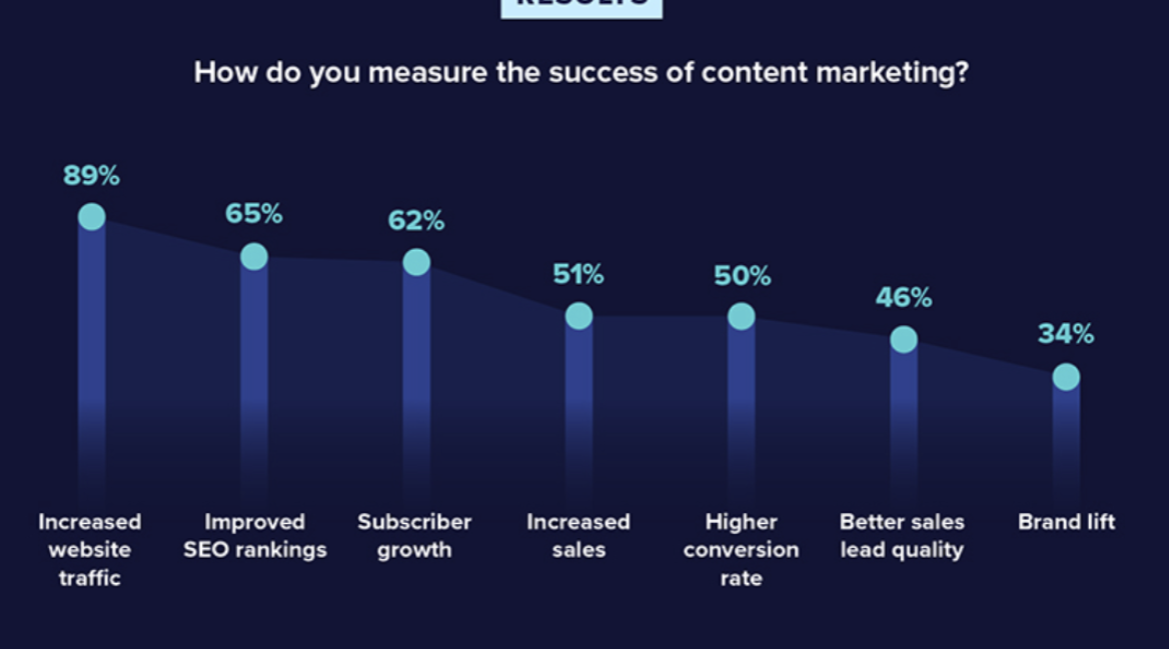
AI in Marketing
Tasks performed by marketers can be augmented by AI to create highly personalized and meaningful connection with customers.